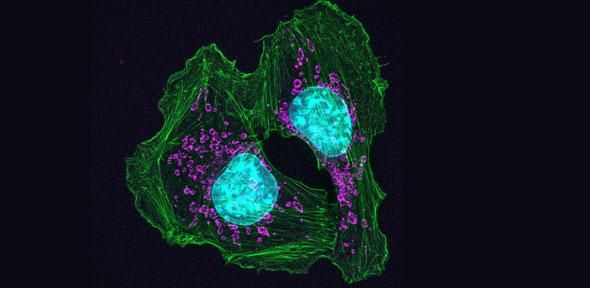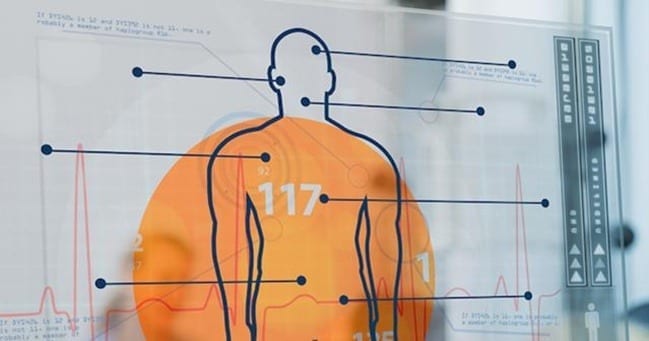
UHFSine photo of the layers created by Sine waves.
By isolating cells into a monolayer within a fluid via acoustic levitation, a group of Utah Valley University researchers created a new method to detect cell stiffness — enabling exploration of cell changes that occur during the metastasis of cancer or other diseases.
Utah Valley University physicists are literally applying rocket science to the field of medical diagnostics. With a few key changes, the researchers used a noninvasive ultrasonic technique originally developed to detect microscopic flaws in solid fuel rockets, such as space shuttle boosters, to successfully detect cell stiffness changes associated with certain cancers and other diseases.
Brian Patchett, a research assistant and instructor within the Department of Physics at Utah Valley University, will describe the group’s method, which uses sound waves to manipulate and probe cells, during the Acoustical Society of America’s Fall 2015 Meeting, held Nov. 2-6, in Jacksonville, Fla.
The method combines a low-frequency ultrasonic wave to levitate the cells and confine them to a single layer within a fluid and a high-frequency ultrasonic wave to measure the cell’s stiffness.
“An acoustic wave is a pressure wave so it travels as a wave of high and low pressure. By trapping a sound wave between a transducer — such as a speaker — and a reflective surface, we can create a ‘standing wave’ in the space between,” explained Patchett. “This standing wave has stationary layers of high and low pressure, a.k.a. ‘anti-nodes,’ and areas, ‘the nodes’ where the pressure remains the same.”
This standing wave allowed the group to acoustically levitate the cells and isolate them in manner similar to their natural state — as they would be within human tissue or the bloodstream. Previous work in this realm relied on “growing the cell cultures in a Petri dish, which tends to deform the structure, as well as create all sorts of interference,” Patchett said.
The significance of the group’s work is that it focuses on an unexplored method of measuring the properties of cells and how they change during the process of cancer and disease development. “The stiffness of the cell is the primary change detected with our high-frequency ultrasound; it reveals detailed information about the internal structure of the cell and how it changes in certain diseases,” Patchett said.
The group’s method can also help distinguish between different types of cancer — such as aggressive breast cancer vs. less aggressive forms. “By isolating the cells in a monolayer of fluid via acoustic levitation, we’re providing a better method for the detection of cell stiffness,” Patchett said. “This method can be used to explore the aspect of cells that changes during Alzheimer’s disease, the metastasis of cancer, or during the onset of autoimmune responses to better understand these conditions and provide insight into possible treatment methods.”
Read more: Sound Waves Levitate Cells to Detect Stiffness Changes That Could Signal Disease
The Latest on: Acoustic levitation
[google_news title=”” keyword=”Acoustic levitation” num_posts=”10″ blurb_length=”0″ show_thumb=”left”]
via Google News
The Latest on: Acoustic levitation
- Eric Church sends Stagecoach festivalgoers for the exits with acoustic gospel seton April 27, 2024 at 11:33 pm
INDIO, Calif. − Eric Church has a reputation for being one of country music's true rebels, with songs such as his quaking blue-collar anthem "How 'Bout You" that asks "I like my country rocking ...
- UPDATE: SCTL Retracts Levitation Claim for PCPOSOS Room Temperature Superconductoron April 24, 2024 at 12:32 pm
New video from SCTL Korea room temperature superconductor experimenters claimed to shows a very strong full levitation effect. Full levitation would be evidence of the Meissner effect found only in ...
- Record Store Day: Houston's Devin the Dude and nine other top releaseson April 18, 2024 at 9:00 am
Top 10 releases, from Bowie to Dwight Yoakam, the Talking Heads to the Replacements, De la Soul to Devin the Dude ...
- Acoustic Energy AE100 MK2: Reviewon April 14, 2024 at 5:00 pm
Do the Acoustic Energy AE100 MK2 Loudspeakers compare favorably with the competition below $500? They should be on your audition list for sure. Very few products that have come and gone over the past ...
- Scientists show off gravity-defying breakthrough in magnetic levitation researchon April 10, 2024 at 12:32 pm
A new study published in Applied Physics Letters highlights how researchers have made huge breakthroughs in magnetic levitation, the use of magnets to cause items to levitate in air for extended ...
- Levitation for Beginners by Suzannah Dunn review – the dark side of a 70s childhoodon April 10, 2024 at 12:27 am
Dunn’s new novel, Levitation for Beginners, returns to the extreme psychological landscapes of these early works. At its centre is a group of girls in their last year at a village primary ...
- Magnetic levitation: New material offers potential for unlocking gravity-free technologyon April 8, 2024 at 10:13 am
Researchers at the Quantum Machines Unit at the Okinawa Institute of Science and Technology (OIST) are studying levitating materials—substances that can remain suspended in a stable position without ...
- Totem Acoustic’s LOON Bookshelf Speakers are Crazy Affordableon April 4, 2024 at 5:00 pm
At $1,299/pair, the Totem Acoustic LOON is the company’s most affordable bookshelf speaker yet. For nearly four decades, Montreal-based Totem Acoustic has been a leader in developing loudspeakers ...
- 8 Best High-End Acoustic Guitars of 2024on April 4, 2024 at 4:21 am
There's no better way to be sure you find your forever instrument than to invest in a high-end acoustic guitar. If you're a singer/songwriter or guitarist like me, your acoustic guitar is like ...
via Bing News










